Keyboard, Electronic Device And Assembly Method Of The Keyboard
Chen; Hung-Chi ; et al.
U.S. patent application number 16/150284 was filed with the patent office on 2020-02-13 for keyboard, electronic device and assembly method of the keyboard. This patent application is currently assigned to Acer Incorporated. The applicant listed for this patent is Acer Incorporated. Invention is credited to Hung-Chi Chen, Shun-Bin Chen, Huei-Ting Chuang.
| Application Number | 20200051758 16/150284 |
| Document ID | / |
| Family ID | 63878573 |
| Filed Date | 2020-02-13 |
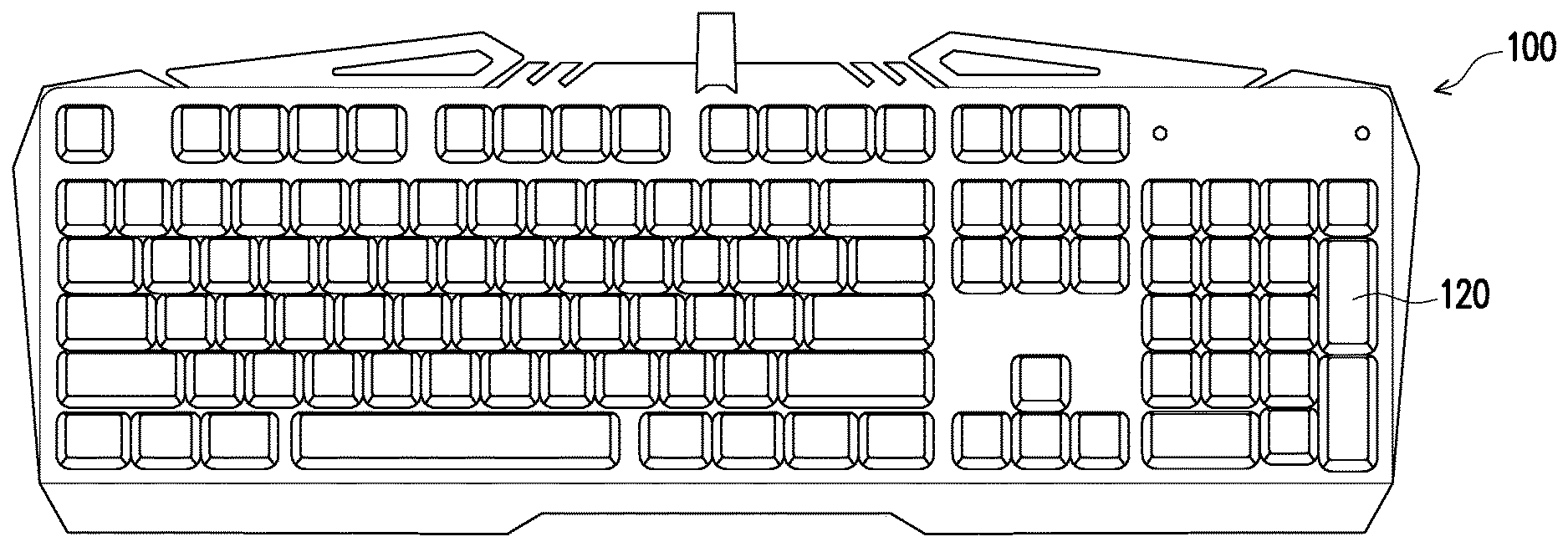

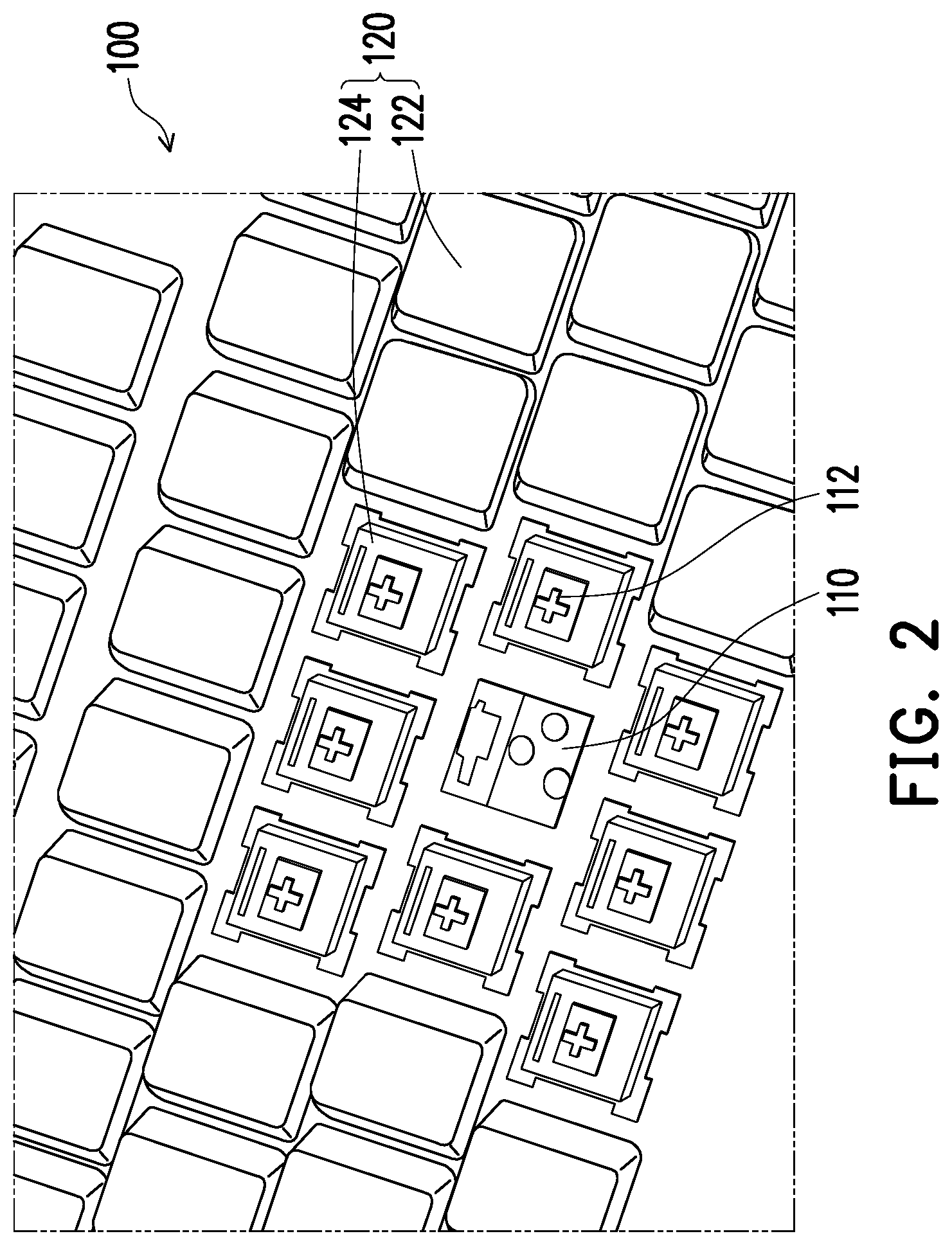
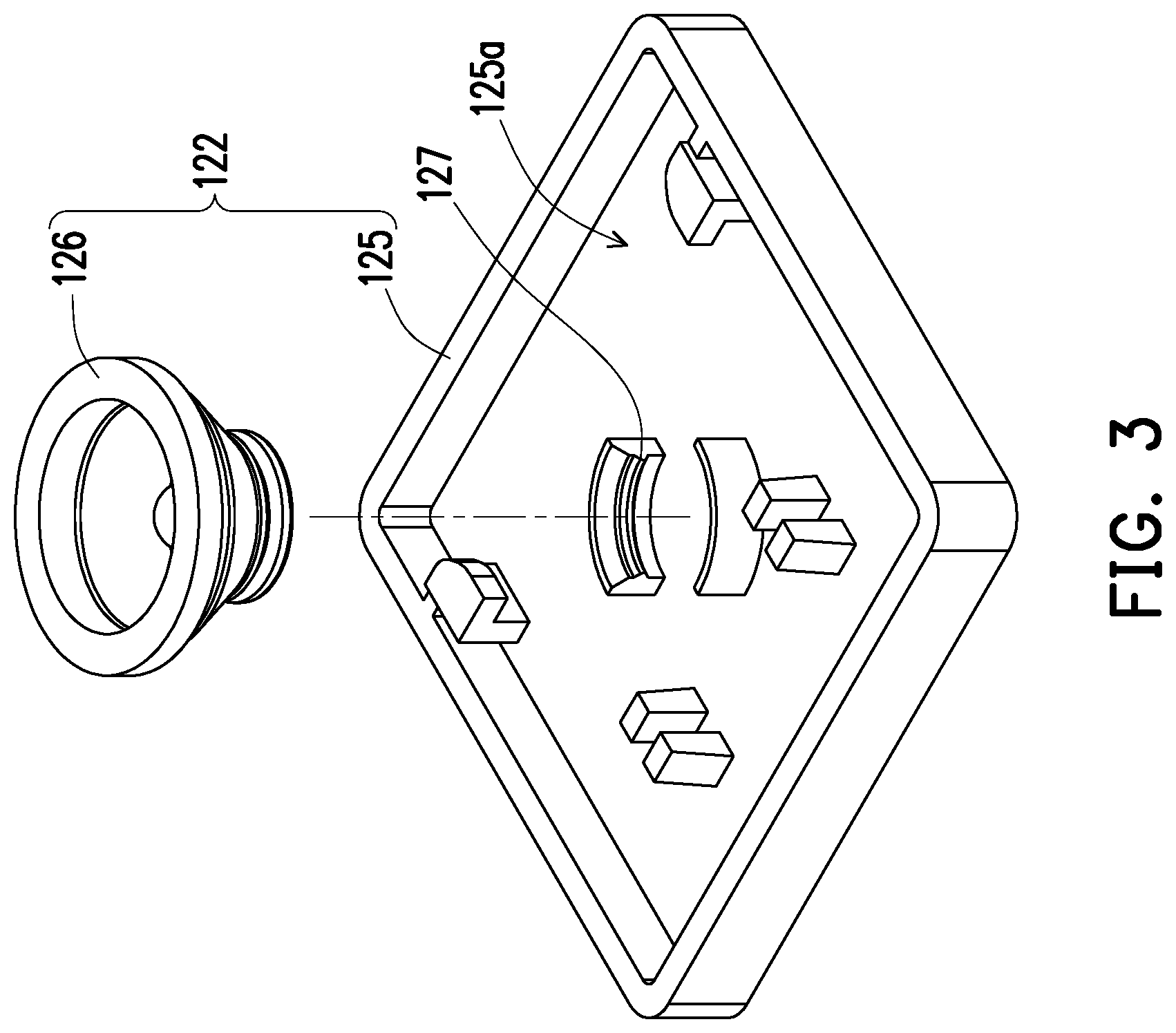

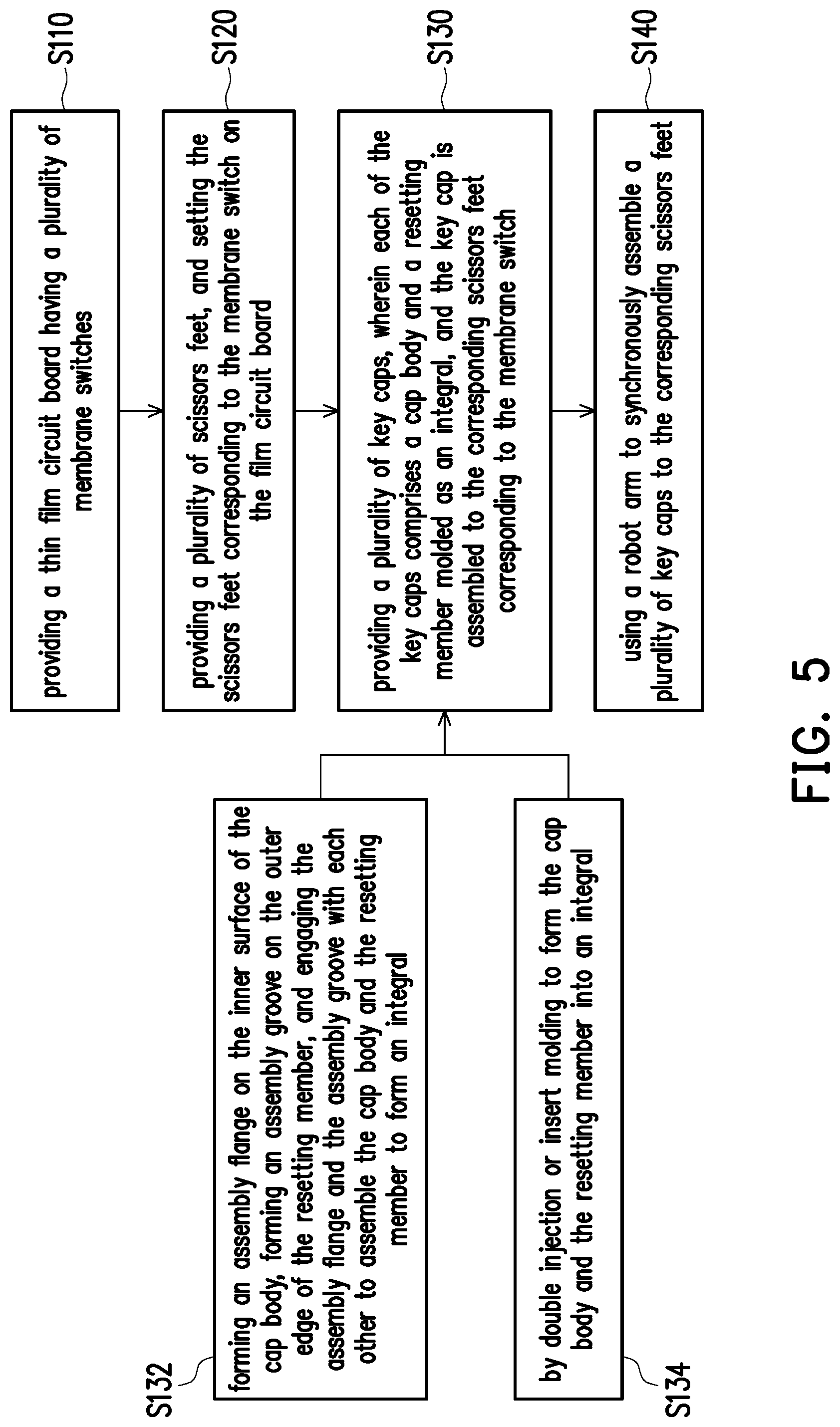

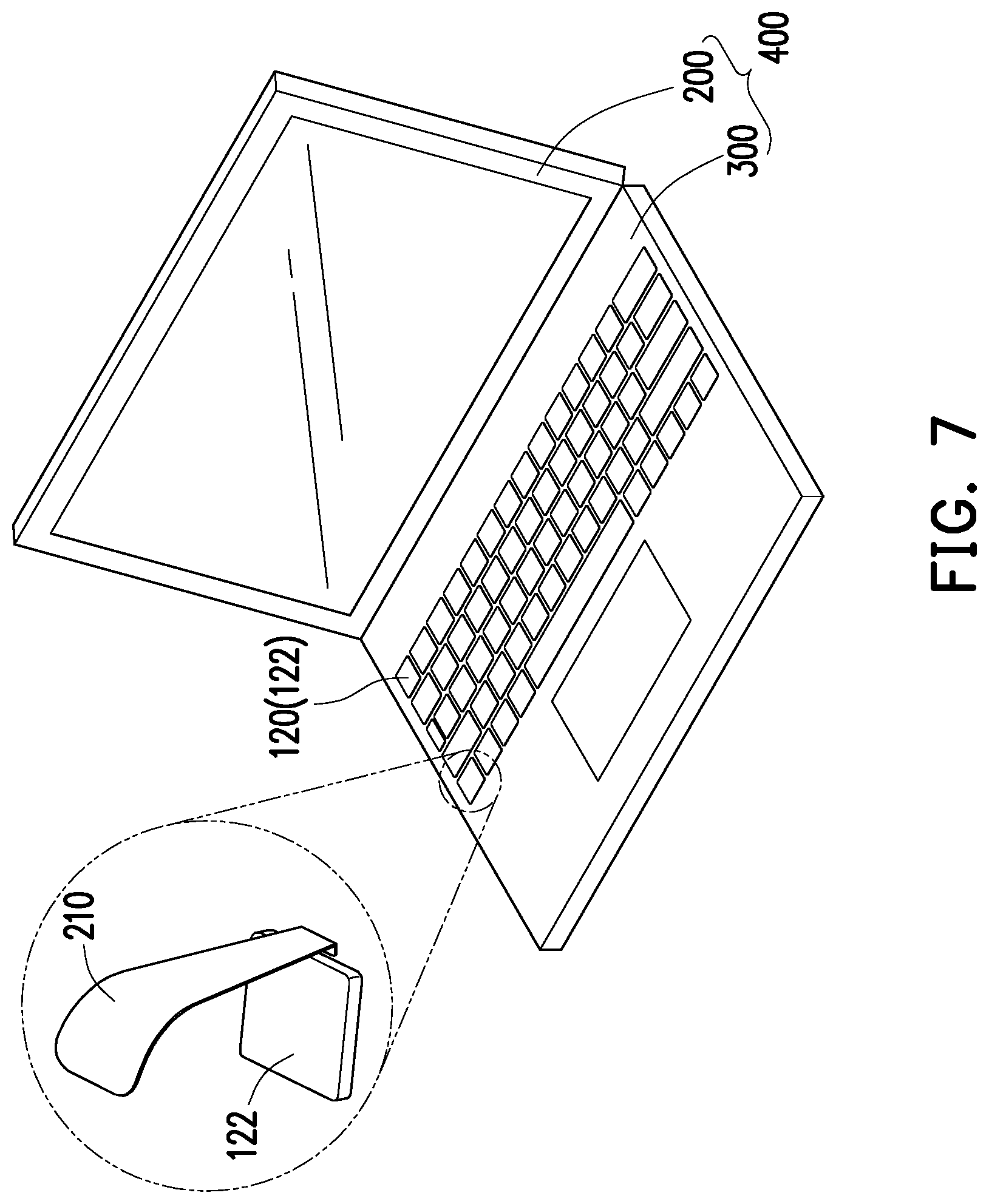
| United States Patent Application | 20200051758 |
| Kind Code | A1 |
| Chen; Hung-Chi ; et al. | February 13, 2020 |
KEYBOARD, ELECTRONIC DEVICE AND ASSEMBLY METHOD OF THE KEYBOARD
Abstract
A keyboard, an electronic device and an assembly method of the keyboard are provided. The electronic device includes a display, the keyboard and a host, wherein the display and the keyboard are electrically connected with the host. The keyboard includes a thin film circuit (TFC) board and multiple buttons. The TFC board has multiple membrane switches with the buttons correspond to the membrane switches, and each of the buttons includes a keycap and a scissor foot. The keycap is used to be pressed to make the corresponding switch being turned on. The keycap includes a cap body and a resetting member, wherein the cap body and the resetting member are formed as an integral, and the scissor feet are connected between the keycap and the TFC board.
| Inventors: | Chen; Hung-Chi; (New Taipei City, TW) ; Chuang; Huei-Ting; (New Taipei City, TW) ; Chen; Shun-Bin; (New Taipei City, TW) | ||||||||||
| Applicant: |
|
||||||||||
|---|---|---|---|---|---|---|---|---|---|---|---|
| Assignee: | Acer Incorporated New Taipei City TW |
||||||||||
| Family ID: | 63878573 | ||||||||||
| Appl. No.: | 16/150284 | ||||||||||
| Filed: | October 3, 2018 |
| Current U.S. Class: | 1/1 |
| Current CPC Class: | H01H 13/705 20130101; H01H 3/125 20130101; H01H 13/88 20130101; G06F 3/0202 20130101; H01H 13/14 20130101; H01H 13/7057 20130101 |
| International Class: | H01H 13/14 20060101 H01H013/14; H01H 13/705 20060101 H01H013/705; H01H 3/12 20060101 H01H003/12; G06F 3/02 20060101 G06F003/02 |
Foreign Application Data
| Date | Code | Application Number |
|---|---|---|
| Aug 7, 2018 | TW | 107127448 |
Claims
1. A keyboard, comprising: a thin film circuit board having a plurality of membrane switches; a plurality of buttons, disposed corresponding to the membrane switches, and each of the buttons comprising: a keycap, for being pressed to cause the corresponding membrane switch to be turned on, wherein the keycap includes a cap body and a resetting member, wherein the cap body is formed with the resetting member as an integral; a scissor foot, coupled between the keycap and the thin film circuit board.
2. The keyboard of claim 1, wherein the cap body and the resetting member are assembled to be an integral.
3. The keyboard of claim 2, wherein the cap body has an assembly flange, and the resetting member has an assembly groove, and the assembly flange and the assembly groove are engaged with each other.
4. The keyboard of claim 1, wherein the cap body and the resetting member are integrally molded by double injection or insert molding.
5. An electronic device, comprising: a display; a keyboard as disclosed in claim 1; and a host, wherein the display and the keyboard are electrically connected to the host.
6. A method of assembling a keyboard, comprising: providing a thin film circuit board, wherein the thin film circuit board has a plurality of membrane switches; providing a plurality of scissor feet and placing the scissor feet on the thin film circuit board corresponding to the membrane switches; and providing a plurality of keycaps, and each of the keycaps including a cap body and a resetting member formed as an integral, wherein the keycaps are assembled to the corresponding scissor feet in accordance with the membrane switches.
7. The method of assembling a keyboard according to claim 6, wherein the cap body and the resetting member are assembled as an integral.
8. The method of assembling a keyboard according to claim 7, wherein an assembly flange is formed on an inner surface of the cap body, an assembly groove is formed on an outer edge of the resetting member, and the assembly flange and the assembly groove are engaged with each other.
9. The method of assembling a keyboard according to claim 6, wherein the cap body and the resetting member are formed as an integral by double injection or insert molding.
10. The method of assembling a keyboard according to claim 6, wherein a robotic arm is used to synchronously assemble the keycaps to the corresponding scissor feet.
Description
CROSS-REFERENCE TO RELATED APPLICATION
[0001] This application claims the priority benefit of Taiwan application serial no. 107127448, filed on Aug. 7, 2018. The entirety of the above-mentioned patent application is hereby incorporated by reference herein and made a part of this specification.
BACKGROUND
Technical Field
[0002] The present invention relates to a keyboard, an electronic device, and a keyboard assembly method, and more particularly to a keyboard, an electronic device, and a keyboard assembly method that can save an assembly process.
Description of Related Art
[0003] The conventional film is that the keyboard is first attached to the thin film circuit board by an individual process, and then the keycaps are assembled to the resetting member and the scissors feet.
[0004] For the assembler, the assembly of the keycap to the resetting member and the scissor foot requires more attention on the alignment, so as to prevent that the keycap is well assembled to the resetting member but is not assembled align with the scissor foot, or the keycap and the scissor foot are well assembled but the resetting member is not aligned. Therefore, the assembly of the keyboard is quite troublesome for the assembler.
SUMMARY
[0005] The present invention provides a keyboard that facilitates replacement of a keycap.
[0006] The present invention provides an electronic device having convenient of use.
[0007] The present invention provides a method of assembling a keyboard that can reduce an assembly process.
[0008] The keyboard of the present invention includes a thin film circuit board and a plurality of buttons. The thin film circuit board has a plurality of membrane switches, the buttons are disposed correspond to the membrane switch, and each of the buttons includes a keycap and a scissor foot. The keycap is used to be pressed to cause the corresponding membrane switch to be turned on, wherein the keycap comprises a cap body and a resetting member, wherein the cap body is formed with the resetting member as an integral, and the scissor foot is connected between the keycap and the thin film circuit board.
[0009] In an embodiment of the invention, the cap body and the resetting member are assembled as an integral, wherein the cap body has an assembly flange, the resetting member has an assembly groove, and the assembly flange and the assembly groove are engaged with each other.
[0010] In an embodiment of the invention, the cap body and the resetting member are formed as an integral by double injection or insert molding.
[0011] The electronic device of the present invention includes a display, a keyboard as described above, and a host, wherein the display and the keyboard are electrically connected to the host.
[0012] The assembling method of the keyboard of the present invention comprises at least the following steps: providing a thin film circuit board, wherein the thin film circuit board has a plurality of film membrane switches; providing a plurality of scissors feet, and disposing the scissors feet corresponding to the membrane switch on the thin film circuit board; and providing a plurality of keycaps, each of which includes a cap body and a resetting member formed as an integral, and the keycap is assembled to the corresponding scissor foot in accordance with to the membrane switch.
[0013] In an embodiment of the invention, an assembly flange is formed on an inner surface of the cap body, an assembly groove is formed on an outer edge of the resetting member, and the assembly flange and the assembly groove are engage with each other, so as to assemble the cap body and the resetting member as an integral.
[0014] In an embodiment of the invention, the cap body and the resetting member are formed as an integral by double injection or insert molding.
[0015] In an embodiment of the invention, a robotic arm is used to synchronously assemble the keycaps onto the corresponding scissor feet.
[0016] Based on the above, in the assembling method of the keyboard of the present invention, the cap body and the resetting member of the keycap are first assembled into an integral and then all the keycaps are possible to synchronize assembled onto the scissors feet using the robotic arm in a same step. The assembly process can be reduced compared to conventional ones.
[0017] For the detecting person or the end user, since the cap body and the resetting member of the keycap are formed as an integral in the keyboard of the present invention and the electronic device using the same, so that the broken keycaps can be easily replaced at any time according to requirements.
[0018] To make the aforementioned more comprehensible, several embodiments accompanied with drawings are described in detail as follows.
BRIEF DESCRIPTION OF THE DRAWINGS
[0019] The accompanying drawings are included to provide a further understanding of the disclosure, and are incorporated in and constitute a part of this specification. The drawings illustrate exemplary embodiments of the disclosure and, together with the description, serve to explain the principles of the disclosure.
[0020] FIG. 1 is a schematic diagram of a keyboard according to an embodiment of the present invention.
[0021] FIG. 2 is a partial exploded diagram of the keyboard of FIG. 1.
[0022] FIG. 3 is a schematic diagram of a keycap of the button of FIG. 1.
[0023] FIG. 4 is a schematic diagram of the cap body.
[0024] FIG. 5 is a schematic diagram of a method of assembling the keyboard of FIG. 1.
[0025] FIG. 6 is a schematic diagram of an electronic device of the present invention.
[0026] FIG. 7 is a schematic diagram of a keyboard application on a notebook computer.
DESCRIPTION OF THE EMBODIMENTS
[0027] FIG. 1 is a schematic diagram of a keyboard according to an embodiment of the present invention, FIG. 2 is a partially exploded diagram of the keyboard of FIG. 1, and FIG. 3 is a schematic diagram of a keycap of the button of FIG. 1. Referring to FIG. 1, FIG. 2 and FIG. 3 simultaneously, the keyboard 100 includes a thin film circuit board 110 and a plurality of buttons 120. The thin film circuit board 110 has a plurality of membrane switches 112, the buttons 120 are disposed corresponding to the membrane switches 112, and each of the buttons 120 includes a keycap 122 and a scissor foot 124. The keycap 122 is used to be pressed to cause the corresponding membrane switch 112 to be turned on. The keycap 122 includes a cap body 125 and a resetting member 126, wherein the cap body 125 and the resetting member 126 are formed as an integral, and the scissor foot 124 is connected between the keycap 122 and the thin film circuit board 110.
[0028] FIG. 4 is a schematic view of the cap body. Referring to FIG. 3 and FIG. 4 simultaneously, in the present embodiment, the cap body 125 has a set of assembly flanges 127, and the resetting member 126 has a set of assembly grooves 128, thereby engaging the assembly grooves 128 with the assembly flanges 127 for assembling the cap body 125 and the resetting member 126 as an integral.
[0029] In another embodiment, the cap body 125 and the resetting member 126 can be formed into an integral by double injection or insert molding.
[0030] In particular, since the cap body 125 and the resetting member 126 are integrally formed in the present embodiment, the assembly method of the keyboard 100 of the present embodiment is also different from the conventional one. FIG. 5 is a schematic diagram of a method of assembling the keyboard of FIG. 1. Referring to FIG. 2, FIG. 3 and FIG. 5, in detail, the assembling method of the keyboard 100 of the embodiment includes at least the following steps: in step S110, a thin film circuit board 110 is provided, wherein the thin film circuit board 110 has a plurality of membrane switches 112. In step S120, a plurality of scissor feet 124 are provided, and the scissor feet 124 are disposed on the thin film circuit board 110 corresponding to the membrane switch 112. In step S130, a plurality of keycaps 122 are provided, wherein each of the keycaps 122 includes a cap body 125 and a resetting member 126 formed as an integral, and the keycap 122 is assembled onto the corresponding scissor foot 124 in accordance with the membrane switch 112.
[0031] In step S130, each of the keycaps 122 includes a cap body 125 and a resetting member 126 that are formed as an integral, and further in step S132, an assembly flange 127 is formed on an inner surface 125a of the cap body 125, an assembly groove 128 is formed on an outer edge of the resetting member 126, and the assembly flange 127 and the assembly groove 128 are engaged with each other to assemble the cap body 125 and the resetting member 126 as an integral.
[0032] Alternatively, as in step S134, the cap body 125 and the resetting member 126 are formed as an integral by double injection or insert molding.
[0033] Thereafter, as in step S140, a robotic arm (not shown) is used to synchronously assemble the plurality of keycaps 122 onto the corresponding scissor feet 124.
[0034] Compared with the conventional keyboard assembly method, since the resetting members and the scissor feet are all disposed on the thin film circuit board, the keycap needs to be aligned with the resetting member and the scissor foot at the same time, so that the keycap can be well assembled to the resetting member and the scissor foot, so the keycap can be turned on when it is touched. If the keycap is aligned with the resetting member but is not aligned with the scissor foot, the user feels the elastic deformation of the resetting member after the assembled keycap is pressed, and triggers the membrane switch, but lacking the function of the scissors foot that allowing the resetting member to move in a balance and smoothly manner. Otherwise, if the keycap is aligned with the scissor foot but not aligned with the resetting member, the assembled keycap is not restored to an original position after being pressed since the resetting member does not provide elastic restoring force. Therefore, for the assembler, it is particularly laborious and difficult when assembling the keycap to the resetting member and the scissor foot, and the parts are too many for automatically assemble through the robotic arm.
[0035] In contrast, the cap body 125 and the resetting member 126 of the present embodiment have been formed as an integral in advance, so that when the keycap 122 is assembled to the scissor foot 124, only the cap body 125 and the scissor foot 124 need to be paired. Therefore, the keycap 122 can be easily assembled to the thin film circuit board 110 for the assembler. Moreover, since the alignment assembly process is less complicated, a program can be designed for automatically assembling the keycap 122 onto the thin film circuit board 110 by the robotic arm, and all the keycaps 122 of one keyboard 100 are synchronously assembled onto the thin film circuit board 110. In this way, the assembler can do other work that requires more manpower.
[0036] FIG. 6 is a schematic diagram of an electronic device of the present invention. The aforementioned keyboard 100 is applied to an electronic device 400. The electronic device 400 is, for example, a desktop computer. The electronic device 400 includes a display 200, the keyboard 100, and a host 300. The display 200 and the keyboard 100 are both electrically connected to the host 300.
[0037] FIG. 7 is a schematic diagram of a keyboard application on a notebook computer. Referring to FIG. 7, the aforementioned keyboard 100 can also be applied to a notebook computer. Since the keyboard of the current notebook computer has a single button which is broken, the entire group needs to be replaced, or even the entire computer needs to be replaced, so that the user spends a considerable amount of cost. Since the keyboard 100 of the embodiment is applied in a notebook computer, the user can replace the individually damaged button 120 only. Alternatively, it is also possible to replace the frequently used individual button 120 with a type that meets the hand feeling according to the user's use requirements. Therefore, for the end user, the keyboard 100 of the present invention can meet the needs of individual users.
[0038] In addition, the keycap 122 can be removed by an assistance of a hand tool 210 since the keyboard in the notebook computer is arranged closely.
[0039] In summary, in the assembling method of the keyboard of the present invention, the cap body and the resetting member of the keycap are formed or assembled as an integral, so that all the key caps are assembled synchronously to the scissors feet in the same step using the robotic arm. Compared with conventional assembling method, the assembly process can be reduced and is more suitable for automated assembly.
[0040] In addition, in the keyboard of the present invention and the electronic device using the same, since the cap body and the resetting member of the keycap are formed as an integral, the broken keycap can be easily replaced individually at any time according to requirements, so it is convenient for the detecting personnel or the end user.
[0041] It will be apparent to those skilled in the art that various modifications and variations can be made to the disclosed embodiments without departing from the scope or spirit of the disclosure. In view of the foregoing, it is intended that the disclosure covers modifications and variations provided that they fall within the scope of the following claims and their equivalents.
* * * * *
D00000

D00001

D00002

D00003

D00004

D00005

D00006

D00007

XML
uspto.report is an independent third-party trademark research tool that is not affiliated, endorsed, or sponsored by the United States Patent and Trademark Office (USPTO) or any other governmental organization. The information provided by uspto.report is based on publicly available data at the time of writing and is intended for informational purposes only.
While we strive to provide accurate and up-to-date information, we do not guarantee the accuracy, completeness, reliability, or suitability of the information displayed on this site. The use of this site is at your own risk. Any reliance you place on such information is therefore strictly at your own risk.
All official trademark data, including owner information, should be verified by visiting the official USPTO website at www.uspto.gov. This site is not intended to replace professional legal advice and should not be used as a substitute for consulting with a legal professional who is knowledgeable about trademark law.